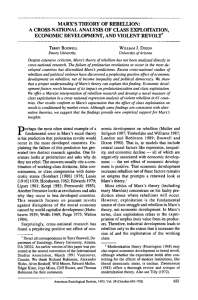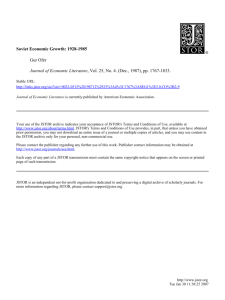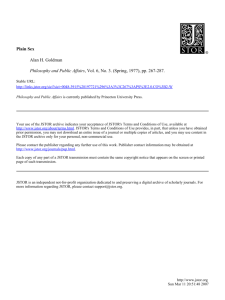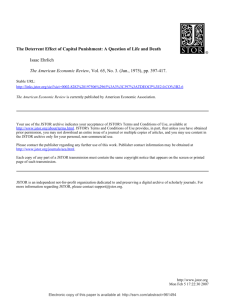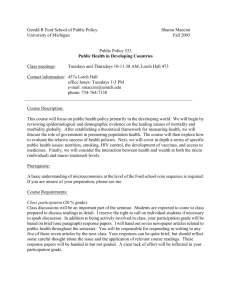Interpreting the Statistical Failures of Some Rational Expectations Macroeconomic Models
advertisement
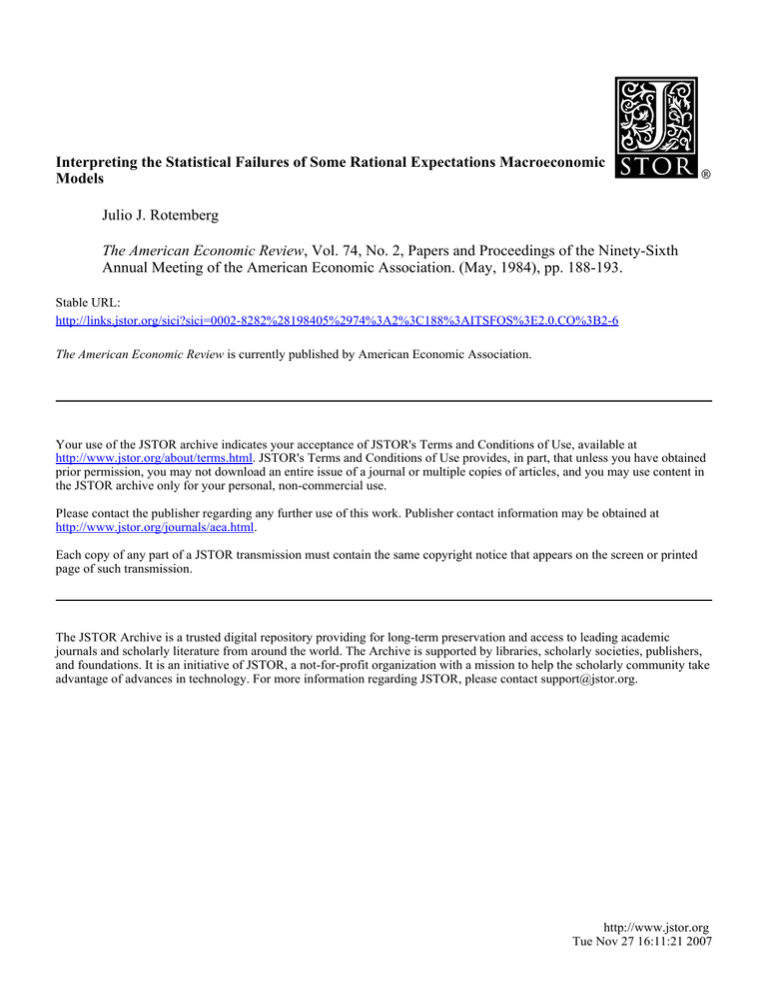
Interpreting the Statistical Failures of Some Rational Expectations Macroeconomic Models Julio J. Rotemberg The American Economic Review, Vol. 74, No. 2, Papers and Proceedings of the Ninety-Sixth Annual Meeting of the American Economic Association. (May, 1984), pp. 188-193. Stable URL: http://links.jstor.org/sici?sici=0002-8282%28198405%2974%3A2%3C188%3AITSFOS%3E2.0.CO%3B2-6 The American Economic Review is currently published by American Economic Association. Your use of the JSTOR archive indicates your acceptance of JSTOR's Terms and Conditions of Use, available at http://www.jstor.org/about/terms.html. JSTOR's Terms and Conditions of Use provides, in part, that unless you have obtained prior permission, you may not download an entire issue of a journal or multiple copies of articles, and you may use content in the JSTOR archive only for your personal, non-commercial use. Please contact the publisher regarding any further use of this work. Publisher contact information may be obtained at http://www.jstor.org/journals/aea.html. Each copy of any part of a JSTOR transmission must contain the same copyright notice that appears on the screen or printed page of such transmission. The JSTOR Archive is a trusted digital repository providing for long-term preservation and access to leading academic journals and scholarly literature from around the world. The Archive is supported by libraries, scholarly societies, publishers, and foundations. It is an initiative of JSTOR, a not-for-profit organization with a mission to help the scholarly community take advantage of advances in technology. For more information regarding JSTOR, please contact support@jstor.org. http://www.jstor.org Tue Nov 27 16:11:21 2007 Interpreting the Statistical Failures of Some Rational Expectations Macroeconomic Models This paper attempts to gauge the economic importance of the statistical rejections of empirical rational expectations models by concentrating on two examples; the first is concerned with aggregate consumption, the second with labor demand. One of the principal advantages of rational expectations macroeconomic models over previous ones is that the former are subject to meaningful statistical tests. These tests typically check whether aggregate data contain correlations which the model doesn't predict. In prerational expectations macroeconomic models, it is relatively straightforward to amend the model to take into account the correlations present in the data. This is much harder to do in the context of rational expectations models. In many of these models the estimated parameters are parameters of the objective functions of economic agents. These parameters are estimated by fitting these agents' reaction functions. When correlations are present that are not predicted by the specific objective function under consideration, it is difficult to know how to parsimoniously change the objective function. So, it isn't too surprising that the first generation of published empirical rational expectations models have been statistically rejected by the data to which they have been applied. These models are extremely simple in many dimensions, so it is undoubtedly too early to predict the demise of the rational expectations research program on the basis of these failures. On the other hand, it is important to discuss whether all we can learn from these empirical efforts is that different (and presumably more complex) models are needed. *Massachusetts Institute of Technology, E52-434. Cambridge. MA 02139. I thank Olivier Blanchard. Lars Hansen, Jim Poterba, and Lawrence Summers for helpful discussions. Rational expectations models attempt to estimate parameters which are not subject to the critique of Robert Lucas (1976). Such parameters would remain invariant to changes in economic policy. It is often asserted that the parameters describing the objective functions of economic agents fulfill t h s requirement. This may be problematic insofar as the election of those who change economic policy depends precisely on the objectives of economic agents. It is probably more appropriate to view parameters to be free of the Lucas criticism when they can be used for certain conceptual experiments. One such conceptual experiment asks what the effect of a typical monetary shock is in the context of an unchanged economic policy regime. For this experiment the entire set of covariances between money and other economic variables may well be free of the Lucas criticism. One can probably safely assume that these covariances aren't affected by typical shocks. Another conceptual experiment asks how consumption would respond if preferences were unchanged, but the real interest rate became permanently higher. To answer this question, one would ideally want to know the current utility functions of consumers. Similarly, to discover how much employment would rise if output or the real wage were permanently hgher, one would want to know the firm's cost or profit functions. So researchers have tried and continue to try to obtain the parameters of cost, profit, and utility functions. These efforts have generally not managed to account for all the correlations present in the aggregate data under study. However, insofar as these data all suggest similar long-run responses of consumption to interest rates or of employment to output, they shed light on conceptual experiments of interest. Simple, statistically rejected models can be viewed as reasonable VOL. 74 NO. 2 WHA T SUR VIVES OF THE R4 TION.4 L EXPECTA TIONS REVOLUTION? approximations if the data suggest that the parameters of interest lie on a relatively small subset of the parameter space. In t h s paper, I focus only on models of tastes and technology whch are estimated by instrumental variables. This estimation technique is ideally suited for the estimation of rational expectations models. These models almost invariably include equations in which current behavior depends on the mathematical expectation of future variables. The residuals created by replacing these expectations with the actual values of future variables thus can be interpreted as forecast errors. Forecast errors must, by definition, be uncorrelated with variables whose value is currently known. Such variables make ideal instruments. Suppose there are m instruments, one equation, and k parameters. Lars Hansen (1982) shows that, if the model is correctly specified, consistent estimates are obtained by taking k linear combinations of the m inner products of instruments and residuals, and setting them to zero. These k linear combinations are given by a k X m weighting matrix. Hansen also provides a test of the model which can be applied when m exceeds k. The failure of this test has various interpretations. First, it means that the instruments are, in fact, correlated with the residuals. Thus these are not just the forecast errors of rational agents. Either the agents don't forecast rationally, or, more appealingly, the model is incorrectly specified. This misspecification, in turn, can be of two types. First, the model might simply be wrong. The true utility function or production function might have a different functional form, or it might depend on additional variables. Second, the equation's error term may be due in part to randomness of preferences or technology. T h s component of the error term might be serially correlated as well as being correlated with the instruments. Another interpretation, stressed by Jerry Hausman (1978) for a test, is shown by Whtney Newey (1982) to be often equivalent to Hansen's in that different instruments lead to different estimates. In my 1983 paper, 1 show that when the model fails these specification tests, one can obtain arbitrary estimates by vary- 189 ing the weighting matrix. T h s is particularly damaging because, when the model is misspecified, traditional methods for selecting a weighting matrix cease to be applicable. There is no reason to prefer two-stage least squares over any other weighting matrix. T h s could be interpreted as saying that if the model is misspecified even slightly so that estimates obtained using different combinations of k instruments are arbitrarily close to each other, the data nonetheless are consistently with any parameter vector. However, my paper also shows that if one is willing to assume that the misspecification has certain untestable properties, some of thls bleakness is lifted. In particular, suppose one isn't willing to assert that the means of the products of instruments and residuals are equal to zero with probability one. Instead, one is willing only to assume that one's subjective distributions over these means have mean zero. These subjective distributions also have nonzero variances since one isn't sure the model is correctly specified. Then suppose the subjective covariance of the mean of the product of one instrument and the residuals with the mean of the product of another instrument and the residuals is zero. In other words, knowledge of the misspecification caused by one instrument doesn't convey information on the misspecification caused by another. This may be a reasonable set of beliefs particularly when the misspecification is due to random variations in preferences or technology. Moreover, in t h s case the parameters themselves still have economic meaning even though the model is misspecified. One might thus want to obtain the vector of parameter estimates which is, on average, least polluted by the correlation between residuals and instruments. My earlier paper shows that the parameter vector whch in some sense minimizes the effect of misspecification is strictly inside the range of the estimates obtained by using all combinations of only k instruments. This parameter vector minimizes the asymptotic covariance matrix of the misspecified estimates around the true parameters. This suggests analysis of this range when the model fails a specification test. This is intuitively appealing since the failure of the model 190 MA Y 1984 AEA PAPERS A N D PROCEEDINGS is due to the fact that different instruments lead to different estimates. One would like to know how different, from an economic point of view, these estimates actually are. If this range is large, then the data are unable to locate even the parameter vector which keeps the effect of misspecification small. Otherwise the region of parameters which could be used for conceptual experiments is small. It is important to note at the outset that the study of this range presents difficulties in small samples. This is so because, in such samples, different combinations of instruments give rise to different estimates even when the model is correctly specified. In this case, of course, these differences vanish asymptotically. The failure of specification tests asserts that, in some sense, the range of estimates is bigger than it would have been if the model were correct. Moreover, this range doesn't vanish asymptotically for these models. My earlier results concern this asymptotic range, which unfortunately is not just imprecisely estimated, but also probably overstated in small samples. In this paper I study some of these small sample ranges. I focus on those which obtain for a simple model of consumer preferences. T h s model is based on the work of Hansen and Kenneth Singleton (1982). Then I analyze some intertemporal cost functions which incorporate the cost of changing employment. These are inspired by John Kennan (1979). The ranges in both cases are fairly large. I. Consumption Per capita consumption is assumed to be given by the consumption of a single infinitely lived individual who maximizes the expected value of an additively separable utility function. This utility function has constant relative risk aversion so the individual maximizes at t : where El takes expectations conditional on information at time t, C, is consumption at T , p is the discount factor whle y is the index of relative risk aversion. The individual also holds some assets in positive quantities. By giving up one unit of consumption at t, the individual gets P, dollars at t. Investing these in the asset, he receives P,(1 + r,) dollars at t + 1. These are sufficient to purchase P,(1 r,)/Pt+, units of consumption at t + 1. If the individual maximizes utility, he can't be made better off by holding either more or less of the asset. So + where the left-hand side of (2) is the loss in utility from giving up one unit of consumption at t. Hence: where has mean zero conditional on information available at t. Taking logarithms on both sides and approximating ln(1 + E,+,) by the first two terms of the Taylor expansion, + where is the logarithm of p plus half of the variance of which is assumed to be constant. Estimates of y and can be obtained by instrumental variables applied in equation (4). I use seasonally adjusted per capita nondurable consumption for C,, the nondurable consumption deflator for PI, and experiment with various different returns for r,. In particular I consider the after-tax return on the S&P 500. T h s return is constructed by applying different tax rates on dividends and on capital gains as explained in my paper with James Poterba (1983). I also consider the after-tax return on U.S. Treasury bills and on savings accounts. The data are quarterly and extend from the third quarter of 1955 to the first quarter of 1982. The models are first fitted with two-stage least squares using the following seven instruments: a constant, ln(C,/C, -,), l n ( c r - l / c ~ - ~ln(Y/Y-l)? )~ ln(Y-l/'Y-2), ln(l+r,-l)P,-l/P,, and ln(l+r,-,)PI-,/ + VOL. 74 NO. 2 ,. W I f A T SURVIVES O F T H E RATIONAL EXPECTATIONS REVOLUTION? P, - Here Y, is per capita disposable income at t. The model is rejected at the 1 percent level when after-tax Treasury bills and aftertax savings accounts are used but only at the 10 percent level with stock returns. Such rejections throw doubt on the usefulness of the parameter estimates. The main parameter of interest is y. The inverse of y is the intertemporal elasticity of substitution (i.e., the elasticity of C,+,/C, with respect to the return (1 + r,)P,/P,+,). Also a low y implies relatively little risk aversion, a strong substitution effect, and thus a tendency for savings to rise as the real return rises permanently. To see whether the data are relatively unanimous on y , I fit the 21 exactly identified models whch use only two of my seven instruments. When I use the after-tax rate of return on equity, y ranges from -6.42 to 6.85. Negative ys imply a convex utility function. Such a utility function is on a priori grounds inconsistent with the data. It implies that the utility-maximizing agent would consume only zero in many periods. So one might be interested only in the positive ys. The smallest of these is .56 when the equity return is used. When I use the return on Treasury bills, positive y's range from .14 to 12.76. Finally, when I use the after-tax return on savings accounts, they vary from .13 to 8.45. While these are undoubtedly very large regions, they have one thing in common. Namely, they do not include very high ys. These aggregate data point to only moderate risk aversion. This fact may well be useful in dynamic simulations of simple general equilibrium models. On the other hand, the model itself needs to be changed substantially to even account for the correlations present in the aggregate data. First, more goods must be included in (1). However, simple attempts to include leisure in (1) lead to failure as reported by Gregory Mankiw, myself, and Lawrence Summers (1983). T h s failure comes from the inability to obtain reasonable parameter estimates. Second, the model must be modified to explain why rate of return dominated assets like money are willingly held. Some progress in t h s direction is reported in Poterba-Rotemberg. Third, the correlation between consumption and income suggests 191 that some of consumption is carried out by liquidity constrained individuals. Thus modifying the model to take into account some individual heterogeneity appears promising. 11. Labor Demand A standard view is that it is costly for firms to instantaneously adjust the factors that they hire. In the absence of these costs of adjustment they would hire N,* employees at t. If they have a different number of employees, their costs are higher. For larger employment, these additional costs are in the form of larger wage bills. For lower employment, the firm must ask its workers to work overtime, thus raising costs and reducing efficiency. On the other hand, changing employment is costly due to the need to pay training and severance pay. Thus a firm may minimize the expected value of total employment related costs which are given by where n, is the logarithm of N, whle R,,,is the discount factor applied at t to costs mcurred at 7. For a firm to be minimizing costs, the derivative with respect to n, in (5) must be zero: By increasing n,, the firms induces ( n ,- n f ) costs of being away from nT, incurs P(n, n, - ,) adjustment costs, but reduces the expected value of future adjustment costs by the E, R,, ,+,P(n,+, - n,). The sum of these additions to costs must be zero. Equation (6) can be estimated once nT is specified. Kennan assumes that nT is proportional to the logarithm of total production q,. As in Kennan, I apply the model separately to the total manufacturing of durables and nondurables. The industrial production of these sectors provides the measure of q,. The data on employment and production are seasonally adjusted, and both a linear trend and the MA Y 1984 A EA PAPERS A N D PROCEEDINGS 192 mean of the variables have been removed. I use the after-tax nominal return on equity as the nominal rate of interest by which future costs are discounted. To obtain the real discount factor R,<,+ I use the wholesale price index of the corresponding sector. So R,,,,, in nondurables is given by Pry / [ ( l r,)PIN] where PINis the price index for nondurables at t and r, is the rate of return on equity. The discount factor for durables is constructed analogously. These considerations allow ( 6 ) to be rewritten as a regression equation. ,, + where E , + , has mean zero conditional on information available at t whle a is the long-run elasticity of employment with respect to production. I first estimate t h s equation by two-stage least squares using data from the third quarter of 1954 to the first quarter of 1982. The equation is rejected in both sectors with 99 percent confidence when I use as instruments the detrended values at t and t - 1 of employment, production, and real hourly earnings in each sector. I then estimate for each sector the 15 models which use only two of these six instruments. The resulting polyhedron of estimates is quite large. For nondurables, a ranges from .03 to 6.84 while /3 ranges from - 56.71 to 383.35. Similarly for durables, a varies between - 1.44 and 5.41 while P varies between -48.16 and 249.98. Once again, negative values of a and /3 can be dismissed on a priori grounds. Negative as mean that more detrended output is ideally produced with fewer employees. Negative p s make it optimal to induce large fluctuations in employment from period to period. Such negative values would thus have zero likelihood if the model were completely specified. Even so, the smallest positive 0 s are 3.88 for durab l e ~and 2.21 for nondurables. The smallest positive a for a set of estimates with positive p is .69 for durables and .72 for nondurables. The long-run elasticity of employment with respect to output varies by a factor of ten starting at about 2 / 3 . Instead P, the ratio of marginal costs of adjustment to costs of being away from n*, varies by a factor of 100. To see the significance of this variation it suffices to calculate how long it would take n to reach 1 / 2 of the adjustment to its long-run value after a once and for all increase in q,. To make this calculation, I assume R,, is constant and equal to .99. Then it takes less than two quarters to complete half the adjustment if p is 5. On the other hand, if P is 300, half the adjustment takes over three years. So there is substantial uncertainty surrounding the economic importance of these costs of adjustment. A more general model would include other inputs such as capital and its costs of adjustment. Then, n* depends on output, on the costs of various inputs, and on the level of other quasi-fixed factors. Robert Pindyck and I (1983) present such a model and find results whch are much more consistent across instrument lists. However, we do not analyze as many lists of instruments as are considered here. Incidentally, we find rather small costs of adjusting labor. Finally, insofar as the misspecification is due to the presence of taste shocks in ( 4 ) or technology shocks in (7), these need to be modeled explicitly to discuss which instruments remain valid. ,+, 111. Conclusions I have shown that for some very simple macroeconomic models, the statistical rejections to which they are subject have economic meaning. The rejections mean that different parts of the data lead to different estimates. The economic meaning of these rejections is that the difference between the various estimates is large. This makes it hard to pin down even the parameter vector which is least affected by misspecification. However, in the case of the consumption model, the data consistently suggest that the parameter of relative risk aversion is fairly small. It is hoped that along the road towards models which actually account for all the correlations present in aggregate data, some models will be found which are better in the following sense. While these models will fail specification tests, the region of parameters VOL. 74 .NO. 3 WHAT SUR VIVES OF THE R4 TIONAL EXPECTA TIONS REVOLUTION? which different data point to will be small enough to allow us to make some meaningful economic inferences. REFERENCES Hansen, Lars R., "Large Sample Properties of Method of Moments Estimators," Econometric~,July 1982, 50, 1029-54. and Singleton, Kenneth J., "Generalized Instrumental Variable Estimation of Nonlinear Rational Expectations Models," Econometrica, September 1982, 50, 126987. Hausman, Jeny A., "Specification Tests in Econometrics," Econometrica, November 1978, 46, 1251-72. Kennan, John, "The Estimation of Partial Adjustment Models with Rational Expectations," Econometrica, November 1979, 47, 1441-56. Lucas, R. E., Jr., "Econometric Policy Evalua- 193 tion: A Critique," in Karl Brunner and Allan Meltzer, eds., The Phillips Curve and Labor Markets, Vol. 1, Carnegie-Rochester Conferences on Public Policy, Journal of Monetary Economics, Suppl., 1976, 19-46. Mankiw, G. N., Rotemberg, J. J., and Summers, L. H., "Intertemporal Substitution in Mac- roeconomics," mimeo., 1983. Newey, Whitney K. "Generalized Method of Moments Specification Testing," mimeo., 1982. Pindyck, Robert S. and Rotemberg, Julio J., "Dynamic Factor Demands and the Effect of Energy Price Shocks," American Economic Review, December 1983, 73, 106679. Poterba, James and Rotemberg, Julio J., ''Money in the Utility Function: An Empirical Implementation," mimeo., 1983. Rotemberg, J. J., "Instrumental Variable Estimation of Misspecified Models," mimeo., 1983. http://www.jstor.org LINKED CITATIONS - Page 1 of 2 - You have printed the following article: Interpreting the Statistical Failures of Some Rational Expectations Macroeconomic Models Julio J. Rotemberg The American Economic Review, Vol. 74, No. 2, Papers and Proceedings of the Ninety-Sixth Annual Meeting of the American Economic Association. (May, 1984), pp. 188-193. Stable URL: http://links.jstor.org/sici?sici=0002-8282%28198405%2974%3A2%3C188%3AITSFOS%3E2.0.CO%3B2-6 This article references the following linked citations. If you are trying to access articles from an off-campus location, you may be required to first logon via your library web site to access JSTOR. Please visit your library's website or contact a librarian to learn about options for remote access to JSTOR. References Large Sample Properties of Generalized Method of Moments Estimators Lars Peter Hansen Econometrica, Vol. 50, No. 4. (Jul., 1982), pp. 1029-1054. Stable URL: http://links.jstor.org/sici?sici=0012-9682%28198207%2950%3A4%3C1029%3ALSPOGM%3E2.0.CO%3B2-O Generalized Instrumental Variables Estimation of Nonlinear Rational Expectations Models Lars Peter Hansen; Kenneth J. Singleton Econometrica, Vol. 50, No. 5. (Sep., 1982), pp. 1269-1286. Stable URL: http://links.jstor.org/sici?sici=0012-9682%28198209%2950%3A5%3C1269%3AGIVEON%3E2.0.CO%3B2-G Specification Tests in Econometrics J. A. Hausman Econometrica, Vol. 46, No. 6. (Nov., 1978), pp. 1251-1271. Stable URL: http://links.jstor.org/sici?sici=0012-9682%28197811%2946%3A6%3C1251%3ASTIE%3E2.0.CO%3B2-X The Estimation of Partial Adjustment Models with Rational Expectations John Kennan Econometrica, Vol. 47, No. 6. (Nov., 1979), pp. 1441-1455. Stable URL: http://links.jstor.org/sici?sici=0012-9682%28197911%2947%3A6%3C1441%3ATEOPAM%3E2.0.CO%3B2-X http://www.jstor.org LINKED CITATIONS - Page 2 of 2 - Dynamic Factor Demands and the Effects of Energy Price Shocks Robert S. Pindyck; Julio J. Rotemberg The American Economic Review, Vol. 73, No. 5. (Dec., 1983), pp. 1066-1079. Stable URL: http://links.jstor.org/sici?sici=0002-8282%28198312%2973%3A5%3C1066%3ADFDATE%3E2.0.CO%3B2-J


